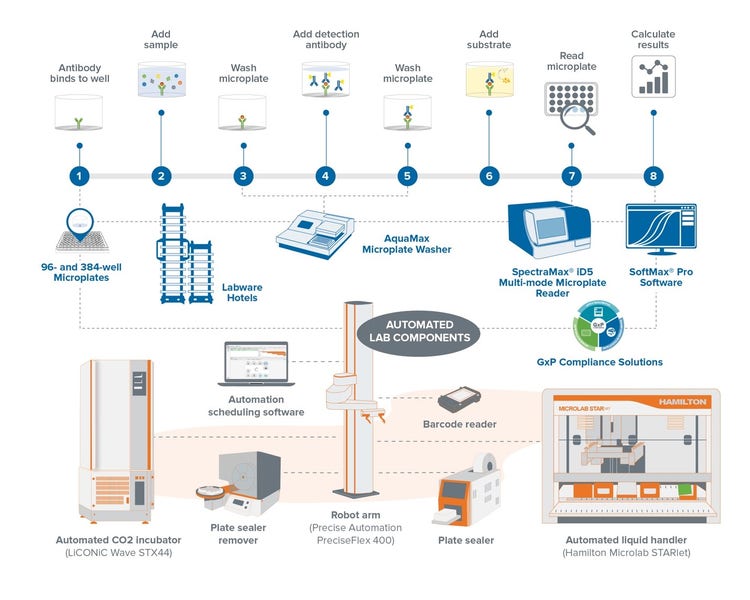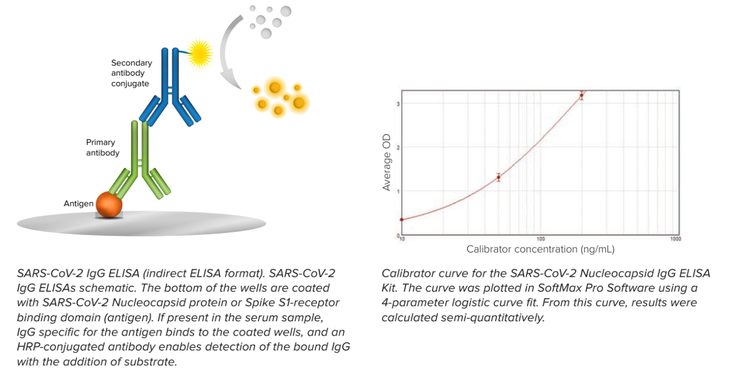
Vorteile des ELISA für eine sorgfältige und beschleunigte Wirkstoffforschung
Seit seiner Entdeckung vor fast Jahren hat sich der Enzyme-Linked Immunosorbent Assay (ELISA) zum Goldstandard der Diagnostik und Wirkstoffbewertung entwickelt. Mit einem ELISA kann man ein Molekül von Interesse (z. B. Protein, Peptid oder Hormon) in einer flüssigen Probe quantifizieren, indem man es auf einer Mikroplatte immobilisiert, spezifische Antikörper verwendet, um dieses Molekül zu binden, und die spezielle Bindung mit hoher Empfindlichkeit detektiert. Die Technik ist trotz der Entwicklung anderer Methoden wie der Durchflusszytometrie aufgrund ihrer Spezifität und Vielseitigkeit beliebt geblieben.
Erfahren Sie in unserem aktuellen Podcast, wie unsere Experten ELISA-Assays in ihrer Forschung einsetzen, welche spezifischen Vorteile diese Art von Immunoassay bietet und welche Forschungsrichtungen durch die Verwendung von ELISA eröffnet wurden und vieles mehr:
Drei erfahrene Wissenschaftler diskutieren, was den ELISA hervorhebt und wie er an die sich schnell entwickelnde Wirkstoffforschungsszene angepasst werden kann. Wichtige Lernpunkte:



ELISA-Anwendungen in der Wirkstoffforschung und -entwicklung
Unsere drei Experten diskutieren, wie sie ELISA-Assays einsetzen, um ihre Forschung in der Wirkstoffforschung und -entwicklung zu unterstützen.
Wirksamkeit therapeutischer Antikörper gegen Zytokine
Für Kyowa Kirin ist der ELISA ein kritischer Kontrollpunkt zur Beurteilung der Wirksamkeit therapeutischer Antikörper gegen inflammatorische Zytokine. Durch die Messung der Zytokinspiegel wie Interferon-gamma, IL-8 und TNF-alpha beurteilen Dey und ihre Kollegen die Fähigkeit ihrer Antikörperklonen, die Produktion dieser Zytokine zu blockieren. Dies hilft ihnen bei der Auswahl der wirksamsten Antikörperklonen.
Beurteilung der pharmakokinetischen Eigenschaften therapeutischer Antikörper
ELISAs haben Dr. Miletic und Frau Dey auch dabei geholfen, die pharmakokinetischen Eigenschaften therapeutischer Antikörper zu beurteilen. In diesen Studien misst das Team das Vorhandensein des Antikörpers im Blut eines Patienten zu verschiedenen Zeitpunkten. Dieser Prozess hilft ihnen dabei, die Halbwertszeit der therapeutischen Informationen zu bestimmen, die ihre Auswahl der stabilsten Antikörperklone bestimmen.
Beurteilung der reduzierten p53-Konzentration in Knockout-Zellen
Molecular Devices hat den Wert einer Vielzahl von ELISAs für ein breites Spektrum an Forschungsansätzen demonstriert, einschließlich CRISPR-Knock-Out-Experimente . Ein Beispiel ist das Knock-Out des p53-Gens, das einen Tumorsuppressor kodiert. Die Verwendung eines ELISA zur Beurteilung der reduzierten p53-Konzentrationen in Knockout-Zellen demonstriert die Nützlichkeit der Methode zur Gewinnung von Erkenntnissen über die Genfunktion, die letztendlich die Entwicklung neuartiger zielgerichteter Therapien vorantreiben könnte.
Vorteile von ELISA-Assays im Vergleich zu anderen Immunoassays
Die drei oben genannten Beispiele zeigen die Vielseitigkeit von ELISAs, aber zusätzliche Faktoren unterscheiden sie von anderen Immunoassays.
Cathy Olsen betont die Flexibilität und Empfindlichkeit von ELISAs: „ELISAs können sehr hochempfindlich und spezifisch sein. Sie sind in der Regel mit unterschiedlichen Messungen erhältlich, je nachdem, was benötigt wird. Kolorimetrische ELISAs, die Absorptionsdetektion als Ablesung verwenden, gibt es seit 30 Jahren. Dennoch gibt es auch fluoreszente und lumineszente Messungen, die Ihnen eine bessere Empfindlichkeit und einen besseren dynamischen Bereich bieten können. Dank der hohen Empfindlichkeit kann ein ELISA Moleküle in der Probe mit geringer Abundanz nachweisen.“
Für Ana Miletic ist die Spezifität ein wichtiges Merkmal von ELISAs, das es ihnen ermöglicht, zwischen eng verwandten Proteinen zu unterscheiden. Dennoch ist die Wahl des Antikörpers der Schlüssel. „Ein ELISA ist nur so gut wie die darin verwendeten Antikörper. Das Rückgrat jedes ELISA-Assays, der es zu einem großartigen Assay macht, ist die Verwendung spezieller Antikörper mit hoher Affinität für Ihr Ziel von Interesse.“ Mit anderen Worten, die richtige Antikörperauswahl trägt dazu bei, den Nachweis des Zielanalyten sicherzustellen und minimiert das Risiko einer Kreuzreaktivität mit ähnlichen Molekülen.
Ein weiterer Vorteil des ELISA ist seine Einfachheit, da nur Platten, Pipetten zum Hinzufügen von Proben und Plattenreader benötigt werden (ein Mikroplatten-Wascher kann hinzugefügt werden, um die Arbeitsbelastung zu erleichtern). Trotz ihres anspruchsvollen Designs können ELISAs ein breites Spektrum an Messungen liefern. Noch wichtiger ist, dass man ELISAs noch zugänglicher und optimierter machen kann, da die meisten Geräte automatisierungsfreundlich sind.
ELISA-Lösungen für Geräte- und Automatisierungs-Workflows
Ein automatisierter ELISA-Arbeitsablauf umfasst mehrere Upgrades auf die manuelle Version, aber das Ausmaß der Automatisierung hängt letztendlich vom Durchsatzbedarf ab.
Automatisierte Pipettierroboter sind sehr nützlich für die Probenvorbereitung und die Zugabe von Reagenzien, während Roboterarme den Transfer von Platten zwischen verschiedenen Abschnitten des Systems bewältigen können. Die Kombination dieser beiden Elemente bedeutet, dass man keine Reagenzien manuell pipettieren oder die Platten vom Labortisch zum Flüssigkeitshandhabungssystem, zurück und zum Plattenwaschgerät und -leser tragen muss. Da der Pipettierroboter und der Roboterarm diese Schritte handhaben, erhält der Forscher mehr Zeit für fokusintensivere Experimente.

Zwei zusätzliche Komponenten machen den Arbeitsablauf noch optimierter. Einer von ihnen ist die Automatisierungsplanungssoftware, die den Zeitplan und die Sequenz des Arbeitsablaufs koordiniert, um zeitgerechtere und präzisere Ergebnisse zu erzielen. Zellbasierte Assays erfordern eine stabile Umgebung für Zellen (z. B. 37o C, 5% CO2), und ein automatisierter Inkubator wird verwendet, um diese Bedingungen konsistent zu erhalten.
Dennoch hält Cathy Olsen den Plattenreader für einen Schlüssel zum Erfolg im automatisierten ELISA. „Die Qualität der Ergebnisse hängt sehr stark von der genauen Erkennung des Signals in der ELISA-Platte ab. Wenn Sie Ihre Daten analysieren, wollen Sie genaue Ergebnisse und eine Quantifizierung des Zielproteins erhalten, das auf den Plattenreader fällt.“ Die Software eines Plattenreaders kann eine automatisierte Analyse mit für einen bestimmten Assay konfigurierten Protokollen ermöglichen.
Der automatisierte ELISA-Arbeitsablauf hat zwei positive Ergebnisse. Erstens, wie bereits erwähnt, nimmt die Gehzeit erheblich zu, sodass Forscher Multitasking durchführen können. Noch wichtiger ist, dass sie menschliche Fehler durch eine einheitliche Probenvorbereitung und ein gut überwachtes Verfahren zur Handhabung von Flüssigkeiten reduzieren kann.
Was die Zukunft für ELISA bereithält
Viele Wissenschaftler nutzen weiterhin die qualitativen und quantitativen Kräfte von ELISAs, und ein aktueller Marktanalysebericht sagt voraus, dass der globale ELISA-Forschungsmarkt von 519,4 Millionen US-Dollar 2022 auf 754,38 Millionen US-Dollar bis steigen wird2030.
ELISAs dienen weiterhin als Maßstab für die Diagnose, indem sie spezifische Antigene in Körperflüssigkeiten nachweisen, und medizinisches Fachpersonal verwendet sie in verschiedenen Bereichen, einschließlich HIV-Tests, Schwangerschaftstests und dem Nachweis von Infektionskrankheiten.
In der jüngsten COVID-19-Pandemie haben ELISAs eine bedeutende Rolle bei der Erweiterung unseres Verständnisses der Krankheitsmechanismen gespielt, indem sie den Nachweis von Antikörpern gegen das Spike-Protein, das Nukleocapsid-Antigen und andere virale Proteine ermöglicht haben. Durch die Messung von Antikörpern, die als Reaktion auf die Impfung produziert wurden, konnten Forscher auch die potenzielle Wirksamkeit eines Impfstoffs beurteilen und dessen Formulierung optimieren.

ELISAs können auch dazu beitragen, den Wirkmechanismus eines Medikaments aufzuklären. Selbst bei Vorhandensein eines Zielproteins muss untersucht werden, wie das Targeting eines bestimmten Proteins funktioniert. Durch die Einführung eines Wirkstoffmoleküls in verschiedene Zelltypen und die Quantifizierung der Konzentrationen an Zielproteinen in diesen Zellen können Forscher die Auswirkungen des Wirkstoffs auf verschiedene zelluläre Prozesse ableiten.
Zukünftige Arbeiten müssen sich darauf konzentrieren, einige der Einschränkungen des ELISA zu adressieren, um sein Potenzial auszuweiten. Ein Schlüsselbereich ist die Erhöhung der Empfindlichkeit, um einen geringen Antigengehalt in einer Probe genau nachzuweisen, was durch Signalamplifikationstechniken erreicht werden kann. Darüber hinaus kann die Optimierung von Blockierungsmitteln Hintergrundrauschen reduzieren und eine unspezifische Antikörperbindung oder Kreuzreaktivität mit ähnlichen Antigenen verhindern. Schließlich ist das Hinzufügen von Multiplexen ein Upgrade, das die gleichzeitige Quantifizierung mehrerer Proteine, Peptide und kleiner Moleküle in der Probe ermöglicht.
Besprechen Sie Ihre automatisierte ELISA-Lösung
Die Automatisierung muss nicht überwältigend sein – es stehen eine Menge Flexibilität und Optionen zur Verfügung. Unsere fünf fertigen Arbeitszellen für ELISA-Arbeitsabläufe bieten Automatisierungslösungen, die von einfachen Plattenladefunktionen bis hin zu fortschrittlicheren, vollständig automatisierten Arbeitszellen reichen und das Beste daran ist, dass sie im Laufe der Zeit angepasst und gebaut werden können. Die Automatisierung arbeitsintensiver plattenbasierter Assays erhöht die Zeit, den Durchsatz und die Reproduzierbarkeit, da der Bedarf eines Forschers verringert wird, sich an häufigen, sich wiederholenden, praktischen Aufgaben zu beteiligen.
https://share.vidyard.com/watch/Nyr9umn2JZ2JaeMkQGw3jQ
Erfahren Sie mehr über unsere ELISA-Arbeitszellen. Wenn Sie bereit sind, mit einem Experten für Workflow-Automatisierung über Ihre Anwendung zu sprechen, kontaktieren Sie uns .